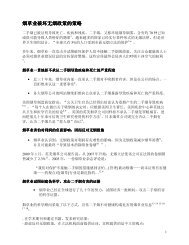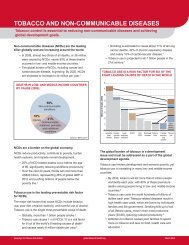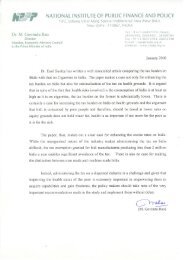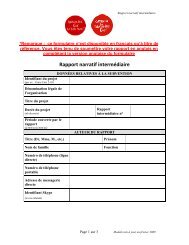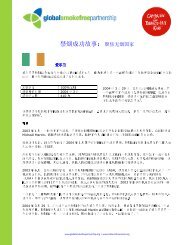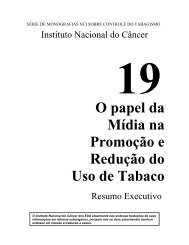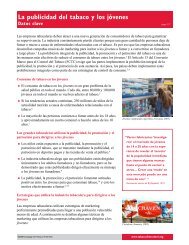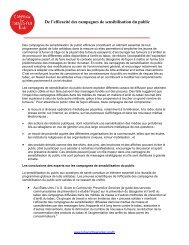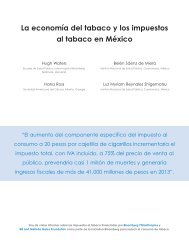Campaign Development Tool Kit - Campaign for Tobacco-Free Kids
Campaign Development Tool Kit - Campaign for Tobacco-Free Kids
Campaign Development Tool Kit - Campaign for Tobacco-Free Kids
You also want an ePaper? Increase the reach of your titles
YUMPU automatically turns print PDFs into web optimized ePapers that Google loves.
<strong>Campaign</strong> <strong>Development</strong> <strong>Tool</strong> <strong>Kit</strong><br />
An International Guide <strong>for</strong> Planning and Implementing<br />
Stop Smoking <strong>Campaign</strong>s<br />
A Project of Global Dialogue <strong>for</strong> Effective Stop Smoking <strong>Campaign</strong>s
Production of this Took <strong>Kit</strong> has been made possible through financial contributions<br />
from Health Canada, Pfizer, and American Cancer Society. The views expressed herein<br />
do not necessarily represent the views of the funders.<br />
The advertisements and photos shown in this tool kit are <strong>for</strong> viewing purposes only.<br />
They cannot be aired or placed publicly without permission from the organizations<br />
that produced and sponsored them. For questions about use of any of the visuals,<br />
please contact info@stopsmokingcampaigns.org.<br />
For more in<strong>for</strong>mation, contact the Global Dialogue <strong>for</strong> Effective Stop Smoking <strong>Campaign</strong>s,<br />
info@stopsmokingcampaigns.org.<br />
Suggested Citation:<br />
Feltracco A, Gutierrez K, <strong>Campaign</strong> <strong>Development</strong> <strong>Tool</strong> <strong>Kit</strong>: An International Guide <strong>for</strong> Planning and Implementing<br />
Stop Smoking <strong>Campaign</strong>s. Brant<strong>for</strong>d, ON: Global Dialogue <strong>for</strong> Effective Stop Smoking <strong>Campaign</strong>s; 2007.<br />
<strong>Tool</strong> <strong>Kit</strong> Icons<br />
In each chapter of the <strong>Campaign</strong> <strong>Development</strong> <strong>Tool</strong> <strong>Kit</strong>: An International Guide <strong>for</strong> Planning and Implementing<br />
Stop Smoking <strong>Campaign</strong>s we have included global examples, case studies, resources and in-depth definitions<br />
or explanations. These materials will help to bring to life the concepts and materials discussed in the <strong>Tool</strong> <strong>Kit</strong>.<br />
To help readers use the <strong>Tool</strong> <strong>Kit</strong>, below is a list of the icons and what they represent.<br />
Case Study Icon<br />
Used <strong>for</strong> individual international case studies that illustrate several concepts<br />
or ideas discussed in the <strong>Tool</strong> <strong>Kit</strong>.<br />
Global icon<br />
Used where we provide brief international examples to illustrate single concepts.<br />
Magnifying Glass icon<br />
Used where more indepth detail and in<strong>for</strong>mation is provided.<br />
Resources icon<br />
Used to identify additional resources of interest.
Table of Contents<br />
Acknowledgements<br />
Forward<br />
Chapter 1: Overview of <strong>Tobacco</strong> Control Marketing <strong>Campaign</strong>s 1.2<br />
Chapter 2: Strategic Planning 2.2<br />
Appendix<br />
2.1: <strong>Campaign</strong> Planning Worksheet 2.25<br />
2.2: Sources of In<strong>for</strong>mation on Demographics and <strong>Tobacco</strong> Control and Use 2.30<br />
2.3: Health Canada’s “Bob and Martin” Smoking Cessation <strong>Campaign</strong> Overview 2.32<br />
III<br />
VII<br />
Table of Contents<br />
Chapter 3: Target Audience Research 3.2<br />
Appendix<br />
3.1: Sample Recruitment Screener <strong>for</strong> Intercept Interviews Regarding Smoking Cessation 3.30<br />
3.2: Sample Recruitment Screener <strong>for</strong> Individual Interviews to Test Advertisements<br />
and Ad Concepts 3.32<br />
3.3: Sample Recruitment Screener <strong>for</strong> Focus Group Discussion 3.35<br />
3.4: Sample Moderator’s Guide <strong>for</strong> Focus Groups with Smokers 3.36<br />
3.5: Sample Advertisement Testing Protocol 3.40<br />
3.6: Sample Target Audience Profile 3.43<br />
Chapter 4: Specific Populations 4.2<br />
Appendix<br />
4.1: <strong>Development</strong> of the First Stop Smoking <strong>Campaign</strong> <strong>for</strong> Māori in New Zealand 4.16<br />
Chapter 5: <strong>Campaign</strong> Evaluation 5.2<br />
Appendix<br />
5.1: Sample General Outline <strong>for</strong> Qualitative Research to Evaluate<br />
Communications Material 5.23<br />
5.2: Sample Evaluation Plan 5.25<br />
5.3: Sample Quantitative Tracking Survey Questionnaire 5.29<br />
5.4: Sample Quantitative Survey of Nonsmokers’ Attitudes, Knowledge and Beliefs<br />
about <strong>Tobacco</strong> Use 5.34<br />
Chapter 6: <strong>Campaign</strong> Management 6.2<br />
Appendix<br />
6.1: Managing the Request <strong>for</strong> Proposals Process 6.21<br />
6.2: Elements of a Creative Brief 6.23<br />
6.3: Sample Creative Brief <strong>for</strong> The Quit Group 6.26<br />
6.4: Sample Creative Brief <strong>for</strong> the U.S. Centers <strong>for</strong> Disease Control and Prevention<br />
and the World Health Organization 6.30<br />
6.5: Sample Creative Brief <strong>for</strong> QUITPLAN® 6.33
6.6: Sample Budget <strong>for</strong> Follow-Up with Smokers Registered <strong>for</strong> 2006 Quit and Win<br />
Program in Three Regions of Ghana 6.35<br />
6.7: Sample Budget <strong>for</strong> Media <strong>Campaign</strong> in Canada 6.38<br />
Chapter 7: Advertising 7.2<br />
Appendix<br />
7.1: Sample <strong>Campaign</strong> Media Plan from Australia 7.28<br />
7.2: Sample <strong>Campaign</strong> Media Plan from New Zealand 7.30<br />
7.3: Sample Media Plan Summary, Including Earned Media from Canada 7.32<br />
Chapter 8: Public Relations 8.2<br />
Appendix<br />
8.1: Case Study on Supporting the Introduction of Smoke-<strong>Free</strong> Workplaces<br />
in Norway 8.29<br />
8.2: Sample Editorial 8.31<br />
8.3: Sample Letter to the Editor 8.32<br />
8.4: Sample Op-Ed 8.33<br />
8.5: Sample Press Release 1 8.35<br />
8.6: Sample Press Release 2 8.37<br />
8.7: Sample Fact Sheet 8.39<br />
8.8: Sample Media Analysis Report (Executive Summary) 8.43<br />
Chapter 9: Media Advocacy 9.2<br />
Appendix<br />
9.1: Media Advocacy in Ireland 9.21<br />
Chapter 10: Community-Based Marketing 10.2<br />
Appendix<br />
10.1: Community Action through Faith Leaders in Cambodia 10.18<br />
Chapter 11: Promoting Stop Smoking Services 11.2<br />
Appendix<br />
11.1: How Environmental Factors Affected Participation Rates in German<br />
Smoke-free <strong>Campaign</strong>s 11.26<br />
11.2: Sample Communications Protocol 11.27<br />
Chapter 12: Funding <strong>Campaign</strong>s 12.2<br />
Appendix<br />
12.1: The Need <strong>for</strong> Effective Mass Media Public Education <strong>Campaign</strong>s As Part<br />
of Comprehensive <strong>Tobacco</strong> Control Programs 12.13<br />
12.2: Sample Stakeholder Briefing Paper 12.19<br />
II<br />
Global Dialogue <strong>Campaign</strong> <strong>Tool</strong> <strong>Kit</strong>
Acknowledgements<br />
Many thanks to all of the individuals and organizations that made this campaign development tool kit possible.<br />
Project Manager<br />
Annamaria Feltracco, Feltracco Consulting, Canada<br />
Technical Editor<br />
Julie Jensen, freelance editor, United States<br />
Acknowledgements<br />
Managing Editors<br />
Annamaria Feltracco, Feltracco Consulting, Canada<br />
Karen Gutierrez, Global Dialogue <strong>for</strong> Effective Stop Smoking <strong>Campaign</strong>s, International<br />
Graphic Design<br />
Vance Merson, Shane O’Brien and Katarina Saric, The Graffic Link Design Studio, Inc., Canada<br />
Funders and In-Kind Contributors<br />
American Cancer Society<br />
<strong>Campaign</strong> <strong>for</strong> <strong>Tobacco</strong>-<strong>Free</strong> <strong>Kids</strong><br />
Department of Health, England<br />
Health Canada<br />
International Non-Governmental Coalition Against <strong>Tobacco</strong><br />
Pfizer<br />
Physicians <strong>for</strong> a Smoke <strong>Free</strong> Canada<br />
Project Team and International Review Panel<br />
Lisa Belluci, Pfizer, International<br />
Cynthia Collard, Physicians <strong>for</strong> a Smoke <strong>Free</strong> Canada, Canada<br />
Annette David, Health Partners, L.L.C., Guam<br />
Marcus Frohe, National Cancer Institute, Brazil<br />
Meg Gallogly, <strong>Campaign</strong> <strong>for</strong> <strong>Tobacco</strong>-<strong>Free</strong> <strong>Kids</strong>, United States<br />
David Graham, Johnson & Johnson, International<br />
Catherine Jo, American Cancer Society, United States<br />
Katerina Langrova, Czech Coalition against <strong>Tobacco</strong>, Czech Republic<br />
Wasim Maziak, Syrian Center <strong>for</strong> <strong>Tobacco</strong> Studies, Syria, and University of Memphis, United States<br />
Krista Scaldwell, Johnson & Johnson, International<br />
Jane Webb, Department of Health, England<br />
Edith Wellington, Ghana Health Service, Ghana<br />
Nan Yi, Centers <strong>for</strong> Disease Control and Prevention, China<br />
III
Expert Reviewers and Contributors:<br />
Linda Bailey, North American Quitline Consortium, United States<br />
Eduardo Bianco, InterAmerican Heart Foundation, Uruguay<br />
Lois Biener, University of Massachusetts, United States<br />
Jack Boomer, Clean Air Coalition of British Columbia, Canada.<br />
Brenda Bryan, North American Quitline Consortium, United States<br />
Sharon Carothers, American Legacy Foundation, United States<br />
Beatriz Champagne, InterAmerican Heart Foundation, International<br />
Siri Christin Naesheim, <strong>Tobacco</strong> Control Department, Directorate <strong>for</strong> Health and Social Affairs, Norway<br />
Greg Connolly, Harvard School of Public Health, United States<br />
Jeffrey Costantino, American Legacy Foundation, United States<br />
Trish Cotter, Cancer Institute New South Wales, Australia<br />
Deena Crawley, McKee Wallwork Cleveland Advertising Agency, United States<br />
Steve Crone, QUIT UK, United Kingdom<br />
Donna Czukar, Canadian Cancer Society – Ontario Division, Canada<br />
Annette David, Health Partners, L.L.C., Guam<br />
Anita Dessaix, Cancer Institute New South Wales, Australia<br />
Mariette Dreher, ClearWay Minnesota, United States<br />
Lorie Dunbar, Office of Programs and Mass Media, <strong>Tobacco</strong> Control Programme, Health Canada<br />
Nancy Dubois, Du-B-Fit Consulting, Canada<br />
Debra Efroymson, HealthBridge, Bangladesh<br />
Larry Elmore, <strong>Tobacco</strong> Use Prevention and Control Program, New Mexico Department of Health, United States<br />
Kristin Engdahl, Edelman Public Relations, United States<br />
Evelyn Fang, Beijing United Family Hospital, China and University of Cali<strong>for</strong>nia San Francisco – Fresno, United States.<br />
Michael Fiore, Center <strong>for</strong> <strong>Tobacco</strong> Research and Intervention, University of Wisconsin School of Medicine and<br />
Public Health, United States<br />
Geoff Fong, International <strong>Tobacco</strong> Control Evaluation Survey Project, University of Waterloo, Canada<br />
Marcus Frohe, National Cancer Institute, Brazil<br />
Meg Gallogly, <strong>Campaign</strong> <strong>for</strong> <strong>Tobacco</strong>-<strong>Free</strong> <strong>Kids</strong><br />
Helen Glasgow, The Quit Group, New Zealand<br />
Alissa Guy, Quit Victoria, Australia<br />
Carol Hall-Walker, Rhode Island Department of Health, United States<br />
David Hammond, Department of Health Studies, University of Waterloo, Canada<br />
Todd Harper, VicHealth, Australia<br />
Carter Headrick, <strong>Campaign</strong> <strong>for</strong> <strong>Tobacco</strong>-<strong>Free</strong> <strong>Kids</strong>, United States<br />
Fenton Howell, Public Health Medicine, Royal College of Physicians, Ireland<br />
Laurent Huber, Framework Convention Alliance, Switzerland<br />
Kari Huseby, <strong>Tobacco</strong> Control Department, Directorate <strong>for</strong> Health and Social Affairs, Norway<br />
Clare Hutchinson, AMV BBDO Advertising Agency, United Kingdom<br />
Lisa Kelly, <strong>Tobacco</strong> Control Program, New York State Department of Health, United States<br />
Nancy Korstanje, Ontario Smokers’ Helpline, Canadian Cancer Society – Ontario Division, Canada<br />
Niki Legge, Cessation Initiatives and <strong>Tobacco</strong> Control, Lung Association of Newfoundland and Labrador, Canada<br />
IV<br />
Global Dialogue <strong>Campaign</strong> <strong>Tool</strong> <strong>Kit</strong>
Ruth Loewen, International <strong>Tobacco</strong> Control Evaluation Survey Project, University of Waterloo, Canada<br />
Wasim Maziak, Syrian Center <strong>for</strong> <strong>Tobacco</strong> Studies, Syria, and University of Memphis, United States<br />
Rich McCracken, Clarity Coverdale Fury Advertising Agency, United States<br />
Danny McGoldrick, <strong>Campaign</strong> <strong>for</strong> <strong>Tobacco</strong>-<strong>Free</strong> <strong>Kids</strong><br />
Jeffrey McKenna, Centers <strong>for</strong> Disease Control and Prevention, United States<br />
Kiann McNeil, Alberta Alcohol and Drug Abuse Commission, Canada<br />
Christine Megerdichian, Harvard School of Public Health, United States<br />
Kristin Mosaker Granborg, Communication and Documentation Department, Directorate <strong>for</strong> Health<br />
and Social Affairs, Norway<br />
Narine Movsisyan, Center <strong>for</strong> Health Services Research and <strong>Development</strong>, American University of Armenia, Armenia<br />
Andrea Mowery, ClearWay Minnesota, United States<br />
David Newton, AMV BBDO Advertising Agency, United Kingdom<br />
Gillian Parrish, Edelman Public Relations, United States<br />
Anita Peter, Cancer Patients Aid Association, India<br />
Paula Pasquali, Community Health Programs, Department of Health and Social Services, Government of Yukon, Canada<br />
Todd Phillips, Academy <strong>for</strong> Educational <strong>Development</strong>, United States<br />
Krzysztof Przewozniak, Cancer Center and Institute of Oncology, Poland<br />
Lezli Redmond, Center <strong>for</strong> <strong>Tobacco</strong> Research and Intervention, University of Wisconsin School of Medicine<br />
and Public Health, United States<br />
Robin Reece, Canadian Network of Smokers’ Helpline, Canada<br />
Abby Rosenthal, Office on <strong>Tobacco</strong> or Health, Centers <strong>for</strong> Disease Control and Prevention, United States<br />
Gary Saffitz, Center <strong>for</strong> Communication Programs, John Hopkins University - Bloomberg School of Public Health<br />
Jonathan Santos, <strong>Tobacco</strong> <strong>Free</strong> Initiative, WHO/Western Pacific Regional Office, Guam<br />
Kawaldip Sehmi, Health and Equality, QUIT UK, United Kingdom<br />
Patti Seikus, Health Communications Branch, Centers <strong>for</strong> Disease Control and Prevention, United States<br />
Karen Slama, Operational Research in <strong>Tobacco</strong> Control, International Union Against Tuberculosis and<br />
Lung Disease, France<br />
Cilla Snowball, AMV BBDO Advertising Agency, United Kingdom<br />
Jin Sook Choi, Korean Association on Smoking and Health, Korea<br />
Sandra Soria, Cali<strong>for</strong>nia Department of Health Services, Chronic Disease and Injury Control<br />
Penny St. John, The Quit Group, New Zealand<br />
Colleen Stevens, Cali<strong>for</strong>nia Department of Health Services, Chronic Disease and Injury Control Division,<br />
<strong>Tobacco</strong> Control Section, United States<br />
Linda Tasi-Mulitalo, The Quit Group, New Zealand<br />
Sarah Tukua, Clarity Coverdale Fury Advertising Agency, United States<br />
Melanie Wakefield, Centre <strong>for</strong> Behavioural Research in Cancer, The Cancer Council Victoria, Australia<br />
Edith Wellington, Ghana Health Service, Ghana<br />
Nan Yi, Centers <strong>for</strong> Disease Control and Prevention, China<br />
Acknowledgements
Forward<br />
This is an exciting and fascinating time to be part of the international tobacco control community. We have<br />
learned how to reduce tobacco use and exposure to secondhand smoke, even as we continue to fight the<br />
<strong>for</strong>midable influence of the tobacco industry with our relative lack of resources. The health gains resulting from<br />
our interventions, contrasted with the high health costs associated with tobacco use, have also generated greater<br />
interest in tobacco control on the part of new international partners. A significant challenge amid these successes<br />
is to leverage the lessons we have learned and disseminate them more broadly so all countries can make progress<br />
toward reducing smoking and exposure to secondhand smoke.<br />
Forward<br />
As the international community continues to learn about and effectively conduct comprehensive tobacco control<br />
programs, several components have emerged as keys to success, and one of them is tobacco control marketing<br />
campaigns. These public education campaigns, conducted through the mass media and other channels, can<br />
increase awareness of tobacco use issues, build relevant knowledge, change beliefs and attitudes, and contribute<br />
to behavior changes. Moreover, Article 14 of the Framework Convention on <strong>Tobacco</strong> Control compels parties<br />
to the convention to design and implement effective programs aimed at promoting tobacco use cessation.<br />
To support effective public education campaigns internationally, and stop smoking campaigns specifically, the<br />
Global Dialogue <strong>for</strong> Effective Stop Smoking <strong>Campaign</strong>s has developed the <strong>Campaign</strong> <strong>Development</strong> <strong>Tool</strong> <strong>Kit</strong>:<br />
An International Guide <strong>for</strong> Planning and Implementing Stop Smoking <strong>Campaign</strong>s.<br />
The tool kit shares “lessons learned” about content of tobacco control marketing campaigns as well as a process<br />
<strong>for</strong> developing such ef<strong>for</strong>ts. It has been designed with input from many sources including the U.S. Centers <strong>for</strong><br />
Disease Control and Prevention’s Designing and Implementing an Effective <strong>Tobacco</strong> Counter-Marketing <strong>Campaign</strong>, the<br />
World Health Organization’s Building Blocks <strong>for</strong> <strong>Tobacco</strong> Control, the U.S. National Cancer Institute’s Making Health<br />
Communications Work, and Health Canada’s Social Marketing E-<strong>Tool</strong>. Responding to the needs of our international<br />
network of campaign planners and researchers, we decided to use many of the chapters from the CDC’s countermarketing<br />
manual as a starting point <strong>for</strong> the tool kit. <strong>Campaign</strong> managers from Africa, Asia, Europe, Oceania,<br />
South America and North America reviewed and helped adapt chapters <strong>for</strong> international audiences. Materials and<br />
documents provided by international contacts from over 25 countries were also incorporated to ensure that the tool<br />
kit examples are as diverse and relevant as possible. The chapters were reviewed by content experts, the project<br />
team, the international review panel and Global Dialogue partners. Each reviewer contributed to making the tool kit<br />
what we hope will be a valuable resource to campaign planners throughout the world, aiding them in developing<br />
campaigns that make significant contributions to reducing the burdens caused by tobacco use and exposure to<br />
secondhand smoke.<br />
The first six chapters of this tool kit focus on an overview of campaigns, strategic planning, target audience research,<br />
specific populations, designing an evaluation plan, and implementing the campaign. The next four chapters<br />
address key components to consider including in your campaign: advertising, public relations, media advocacy<br />
and community-based marketing. The final two chapters focus on promotion of stop smoking services, including<br />
quitlines, and ways to secure and sustain funding <strong>for</strong> your campaign.<br />
VII
We are excited to share this important resource with international tobacco control advocates and hope that it will<br />
provide important and useful guidance to those interested in developing tobacco control marketing campaigns. The<br />
online version of this tool kit will be revised over time to keep it as up-to-date and relevant as possible. Please send any<br />
feedback regarding the tool kit to info@stopsmokingcampaigns.org. We also welcome additional campaign documents<br />
and materials, similar to those found throughout the tool kit. Thank you in advance <strong>for</strong> your contributions!<br />
Karen Gutierrez<br />
Director<br />
Global Dialogue <strong>for</strong> Effective Stop Smoking <strong>Campaign</strong>s<br />
VIII<br />
Global Dialogue <strong>Campaign</strong> <strong>Tool</strong> <strong>Kit</strong>



